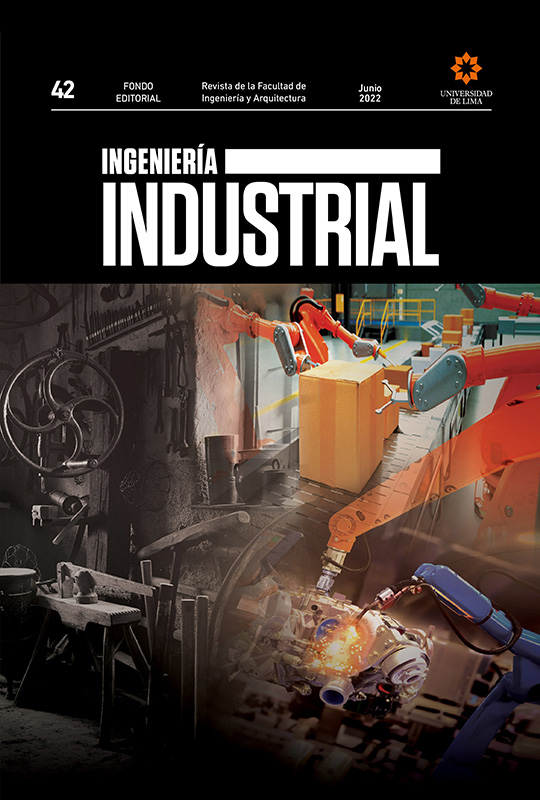Ms. Determination of the operational capacity of the freezing tunnel of a fishing company
DOI:
https://doi.org/10.26439/ing.ind2022.n42.5731Keywords:
design capacity, real capacity, operational parameters, thermal loadAbstract
This study determined the operational capacity of the freezing tunnel of a fishing services company. The operation of the equipment was inspected, the theoretical operational parameters were collected, and in 40 selected points, the speed (1,8 – 4,4 m/s) and temperature (–25 °C and –11 °C) of the air, and the initial and final freezing temperatures of whole gutted mahi-mahi (Coryphaena hippurus) were evaluated. The real operating capacity of the equipment (77,2 kW) was calculated by applying mathematical expressions that allowed to determine the thermal loads, and later it was compared with the design capacity (75 kW). The speed and temperature of the air inside the equipment and the temperature distribution of the product were not uniform. They depended on the location of the fans and the measurement points. These variations affected the thermal loads generated by the product and were directly proportional to the speed of the air and inversely proportional to the temperature in the center of the product. The results showed the tunnel was working above its capacity; freezing times were higher than those reported for mahi-mahi frozen at temperatures between –18 ºC and –20 ºC.
Downloads
References
Binaggia Coto, A. (2007). Manual de operaciones del sistema de refrigeración con amoniaco de la empresa productos EFE, S. A. [Tesis de grado, Universidad Simón Bolívar]. https://silo.tips/download/universidad-simon-bolivar-decanato-de-estudios-profesionales-coordinacion-de-ing-57
Carreño Barrera, P. F., & Jadán Lucero, C. M. (2013). Estudio del comportamiento termodinámico del refrigerante. [Tesis de grado, Universidad Politécnica Salesiana Sede Cuenca]. https://dspace.ups.edu.ec/bitstream/123456789/4803/1/UPS-
CT002646.pdf
Céspedes Urrutia, R. S. (2012). Sistema de refrigeración con capacidad de bodega para almacenar 300 kg de pescado [Tesis de grado, Pontifica Universidad Católica del Perú]. Repositorio PUCP. https://tesis.pucp.edu.pe/repositorio/handle/20.500.12404/1264
Dossat, R. J. (2009). Principio de refrigeración. Grupo Editorial Patria.
Guzmán, W. (2018). Diseño de planta piloto de refrigeración industrial y de estrategia de control [Tesis de grado, Universidad de Piura]. https://hdl.handle.net/11042/3308
Huertas Samayoa, Z. J. (2013). Diseño de sistema frigorífico para control de la maduración de una carga de plátanos [Tesis de grado, Universidad de San Carlos de Guatemala]. http://biblioteca.usac.edu.gt/tesis/08/08_0774_M.pdf
Johnston, W. A., Nicholson, F. J., Roger, A., & Stroud, G. D. (1994). Freezing and refrigerated storage in fisheries. FAO Fisheries Technical Paper 340. FAO.
Lucas Hidalgo, G. (2016). Dimensionamiento y selección de un túnel de congelación para el procesamiento de banano (Musa sapientum) con Paleta [Tesis de grado, Escuela Superior Politécnica del Litoral]. https://es.scribd.com/document/377954469/D-CD88308
Ludeña Quiñones, F. M. (2013). Diseño de un congelador de maíz entero con capacidad de 100 kg/hr [Tesis de grado, Pontifica Universidad Católica del Perú]. Repositorio PUCP. http://hdl.handle.net/20.500.12404/5368
Melgarejo Moreno, P. (2005). Cámaras frigoríficas y túneles de enfriamiento rápido. AMV Ediciones.
Ordóñez Muñoz, J. C. (2006). Preparación y almacenamiento de productos congelados [Tesis de grado, Universidad Austral de Chile]. http://cybertesis.uach.cl/tesis/uach/2006/bmfcio.65p/doc/bmfcio.65p.pdf
Palomo Cano, M. (2017). Aislantes térmicos. Criterios de selección por requisitos energéticos [Trabajo fin de grado, Universidad Politécnica de Madrid]. https://oa.upm.es/47071/1/TFG_Palomo_Cano_Marta.pdf
Pham, Q. T. (1984). Extension to Planck’s equation for predicting freezing times of foodstuffs of simple shapes. International Journal of Refrigeration, 7(6), 377-383. https://doi.org/10.1016/0140-7007(84)90008-2
Programa de las Naciones Unidas para el Medio Ambiente. (2015). Normas internacionales de refrigeración y aire acondicionado. https://wedocs.unep.org/bitstream/handle/20.500.11822/27218/7739IntStandardsRAC_SP.pdf?sequence=3&isAllowed=y
Ramakrishnan, S., Wysk, R. A., & Prabhu, V. V. (2004). Prediction of process parameters for intelligent control of tunnel freezers using simulation. Journal of Food Engineering, 65(1), 23-31. https://doi.org/10.1016/j.jfoodeng.2003.05.001
Santos, C., Carciofi, B., Dannenhauer, C., Hense, H., & Laurindo, J. (2007). Determination of heat transfer coefficient in cooling-freezing tunnels using experimental time-temperature data. Journal of Food Process Engineering, 30(6), 717-728. https://doi.org/10.1111/j.1745-4530.2007.00121.x
Seitz Ling, N. S. (2008). Factibilidad del enfriamiento rápido continuo para fruta fresca. [Tesis de grado, Universidad de Chile]. https://repositorio.uchile.cl/bitstream/handle/2250/103141/seitz_nl.pdf
Valiente M., O. (2001). Refrigeración y congelado de pescado. Editorial Ciencia y Tecnología.
Vélez Navia, D. A. (2011). Diseño de un túnel de congelamiento discontinuo para pescado en la empresa El Dorado en el cantón Esmeraldas [Tesis de grado, Escuela Superior Politécnica de Chimborazo]. http://dspace.espoch.edu.ec/handle/
/1969
Villacreses Zambrano, S. M. (2009). Optimización de un proceso de congelación en Patacón Congelado IQT [Tesis de grado, Escuela Superior Politécnica del Litoral]. https://es.scribd.com/document/213644766/Optimizacion-de-un-Proceso-de-Congelacion-en-Patacon-Tesis
Widell, K. N. & Eikevik, T. (2010). Reducing power consumption in multi-compressor refrigeration systems. International Journal of Refrigeration, 33(1), 88-94. https://doi.org/10.1016/j.ijrefrig.2009.08.006



